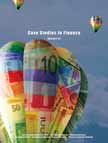Tisco - The EVA Journey
|
|
ICMR HOME | Case Studies Collection
Case Details:
Case Code : FINC035
Case Length : 9 Pages
Period : 1996-2006
Pub. Date : 2004
Teaching Note :Not Available
Organization : TISCO
Industry : Iron and Steel
Countries : India
To download Tisco - The EVA Journey case study (Case Code:
FINC035) click on the button below, and select the case from the list of available cases:

Price:
For delivery in electronic format: Rs. 300;
For delivery through courier (within India): Rs. 300 + Shipping & Handling Charges extra
» Finance Case
Studies
» Short Case Studies
» View Detailed Pricing Info
» How To Order This Case
» Business Case Studies
» Case Studies by Area
» Case Studies by Industry
» Case Studies by Company

Please note:
This case study was compiled from published sources, and is intended to be used as a basis for class discussion. It is not intended to illustrate either effective or ineffective handling of a management situation. Nor is it a primary information source.
Chat with us

Please leave your feedback

|
|




<< Previous
Background Note
The idea of making steel in India was conceived in 1867 when, during a visit to Manchester (UK), Jamshetji Tata, the founder of TISCO, was inspired by a speech made by Thomas Carlyle (famous Scottish writer of 19th century), in which he said, "The nation which gains control of iron, soon acquires control of gold."6
|
Jamshetji Tata returned to India and commissioned a series of studies and analysis for the viability of a steel plant in India, and eventually TISCO was set up in 1907. In 1954, the Indian government established Steel Authority of India Limited (SAIL) with a much larger production capacity as compared to TISCO. The government regulations of controlled pricing of input and output, licensing, and freight equalization favored SAIL. On the other hand, TISCO was not allowed to build up its capacity to derive economies of scale. However, since the domestic steel market was a seller's market during the first four or five decades after independence, TISCO did not face problems in selling its entire output and making reasonable profits during this period.
|

|
In 1991, the Indian economy was liberalized. Import tariffs and custom duties were cut, making steel imports cheaper.
|
|
This put TISCO through a rough period. Financial institutions started funding additional capacities in steel production. A lot of new industrial group/companies like Essar, Lloyds, Jindal, Mittal and Mideast entered the steel industry operating on very low margins.
TISCO soon realized that the technology it had been using was outdated and did not match global standards since now the company had to compete with global steel majors.
To overcome this handicap, Irani invested heavily in technology improvement, instead of focusing only on capacity addition... |
Excerpts >>
|
|









